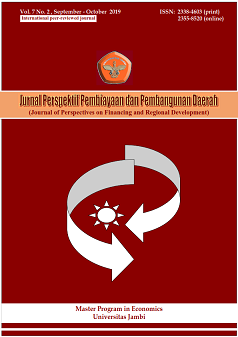Financial capacity of provinces in Sumatra during regional autonomy era
DOI:
https://doi.org/10.22437/ppd.v7i2.7946Abstract
The regional autonomy policy gives greater authority to regencies and cities to take responsibilities both in terms of regional revenue or regional expenditure. Ideally, all the local government expenditures can be fulfilled with their Local Own-source Revenue, so that the region fully becomes an autonomous region which means that the dependence of central government to local decreases. According to the percentage of direct expenditure to total regional revenue of provinces in Sumatra, the average amount is less than 50 percent of regional income. Meanwhile, more than 50 percent of the total regional revenue of provinces in Sumatra is used for indirect expenditure. The average degree of fiscal decentralization of provinces in Sumatra from 2015 to 2017 has amount about 37 percent. It means that the fiscal decentralization degree was low, thus the budgeting performance was poor/bad. Financial independence level of provinces in Sumatra is 57.36 percent which means that the regions are considered to be independent enough in implementing regional autonomy. Financial dependence level of region is about 63.55 percent which means that the fiscal dependence of provinces in Sumatra is great enough and its budget performance is not so good. This shows that the region dependence in Sumatra on the aids from central funds is still very much felt and noticeable.
Downloads
References
Adi, P.H. (2012). Kemampuan Keuangan Daerah Dalam Era Otonomi Daerah dan Relevansinya Dengan Pertumbuhan Ekonomi (Studi pada kabupaten dan kota se Jawa- Bali). Kritis, Jurnal Studi Pembangunan Interdisiplin, XXI(1), 1 - 20.
Altunbas, Y. & Thornton, J. (2011). Fiscal Decentralization and Governance. Public Finance Review, 000(00), 1 – 20
Amril, Erfit & Safri, M. (2015). Flypaper Effect pada Kinerja Keuangan Kabupaten/Kota di Provinsi Jambi. Jurnal Perspektif Pembiayaan dan Pembangunan Daerah, 2(3), 135 - 146
Ekawarna, S.U. (2017). Analisis Flypaper Effect pada Belanja Daerah (Studi Komparasi Daerah Induk dan Pemekaran kabupaten/kota di Provinsi Jambi). Jurnal Perspektif Pembiayaan dan Pembangunan Daerah, 4(3), 167-184
Frediyanto, Y. & Purwanti, E.V. (2010). Analisis Kemampuan Keuangan Kabupaten/Kota di Provinsi Jawa Tengah Sebelum dan Sesudah Kebijakan Otonomi Daerah. Thesis. Semarang: Fakultas Ekonomi Semarang, Universitas Diponogoro.
Halim, A. (2001). Analisis Deskriptif Pengaruh Fiskal Stress Pada APBD Pemerintah Daerah Kabupaten/Kota di Jawa Tengah. Kompak, 2, 127 -146
Kharisma, B. (2013). Desentralisasi Fiskal dan Pertumbuhan Ekonomi, Sebelum dan Sesudah Era Desentralisasi Fiskal di Indonesia. Jurnal Ekonomi dan Studi Pembangunan, 14(2), 101 - 119
Kuncoro, H. (2007). Fenomena Flypaper Effect pada kinerja Keuangan pemerintah daerah Kota dan Kabupaten di Indonesia. Paper presented at Simposium Nasional Akuntansi X Makasar
Kusriyawanto. (2014). Pengaruh penerimaan dan pengeluaran pemerintah daerah terhadap pertumbuhan ekonomi Provinsi – Provinsi di Indonesia sebelum dan sesudah Otonomi Daerah tahun 1994 – 2010. E-Jurnal Katalogis, 2(7), 111 – 123
Mahi, R. (2005). Peran Pendapatan Asli Daerah di Era Otonomi. Jurnal Ekonomi Pembangunan Indonesia, VI(1), 39 - 49
Mardiasmo. (2002). Otonomi Daerah Sebagai Upaya Memperkokoh Basis Perekonomian Daerah. Available at: http://www.ekonomirakyat.org/edisi_4/artikel_3.html
Setiaji, W. & Adi, P.H. 2007. “Peta Kemampuan Keuangan Daerah : Apakah mengalami Pergeseran ? (Studi pada kabupaten dan kota se Jawa- Bali), Paper presented at Simposium Nasional Akuntansi X. Makasar
Thornton, J. (2007). Fiscal Decentralization and Economic Growth Reconsidered. Journal of Urban Economics, 61(1), 64 - 70
Downloads
Published
How to Cite
Issue
Section
License
Copyright (c) 2019 Rosmeli Rosmeli, Nurhayani Nurhayani

This work is licensed under a Creative Commons Attribution 4.0 International License.

















